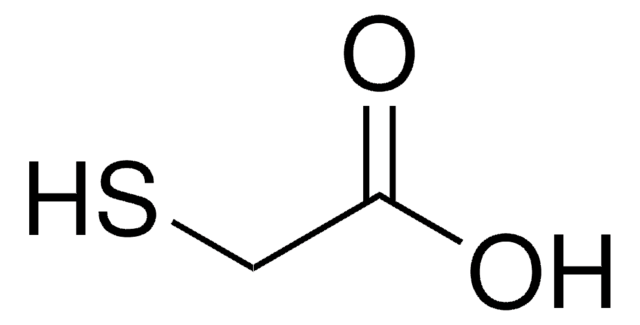1.01737
Barium hydroxide octahydrate
for analysis EMSURE® ACS,ISO,Reag. Ph Eur
Synonyme(s) :
Barium hydroxide octahydrate, Caustic baryta, Barium oxide hydrate octahydrate
About This Item
Produits recommandés
Qualité
ACS reagent
Niveau de qualité
Agence
reag. ISO
reag. Ph. Eur.
Gamme de produits
EMSURE®
Essai
≥98.0% (acidimetric)
Forme
solid
Puissance
550 mg/kg LD50, oral (Rat)
Impuretés
≤0.005% Substances insoluble in dilute hydrochloric acid
pH
14 (20 °C in H2O, saturated aqueous solution)
Pf
78 °C
Densité
2.18 g/cm3 at 20 °C
Masse volumique apparente
900‑1100 kg/m3
Traces d'anions
carbonate (as BaCO3): ≤2.0%
chloride (Cl-): ≤0.001%
sulfide (S2-): ≤0.0005%
Traces de cations
Ca: ≤0.002%
Fe: ≤0.0005%
K: ≤0.01%
Na: ≤0.01%
Pb: ≤0.001%
Sr: ≤0.5%
heavy metals (as Pb): ≤0.0005%
Température de stockage
2-30°C
InChI
1S/Ba.10H2O/h;10*1H2/q+2;;;;;;;;;;/p-2
Clé InChI
ZUDYPQRUOYEARG-UHFFFAOYSA-L
Application
- Determination of phosphorylated and O-glycosylated sites by chemical targeting (CTID) at ambient temperature.: This study explores the use of chemical targeting to identify phosphorylated and O-glycosylated sites, essential for understanding protein modifications. Barium hydroxide is utilized for its effectiveness in ambient temperature conditions, contributing to more efficient analytical methods (Hathaway, 2007).
- Wet-chemical synthesis of crystalline BaTiO3 from stable chelated titanium complex: formation mechanism and dispersibility in organic solvents.: The research demonstrates the wet-chemical synthesis of BaTiO3, highlighting the formation mechanism and its dispersibility. Barium hydroxide plays a crucial role in stabilizing the chelated titanium complex, making it a valuable component in material synthesis and analytical chemistry (Pramanik et al., 2006).
- Synthesis and analgesic effect of normorphine-3- and -6-glucuronides.: This paper details the synthesis of normorphine glucuronides, where barium hydroxide is used in the synthetic process. The study contributes to the understanding of analgesic properties and the chemical synthesis of pharmacologically relevant compounds (Oguri et al., 1989).
Remarque sur l'analyse
Substances insoluble in dilute hydrochloric acid: ≤ 0.005 %
Carbonate (as BaCO₃): ≤ 2.0 %
Chloride (Cl): ≤ 0.001 %
Sulphide (S): ≤ 0.0005 %
Heavy metals (as Pb): ≤ 0.0005 %
Ca (Calcium): ≤ 0.002 %
Fe (Iron): ≤ 0.0005 %
K (Potassium): ≤ 0.01 %
Na (Sodium): ≤ 0.01 %
Pb (Lead): ≤ 0.001 %
Sr (Strontium): ≤ 0.5 %
Corresponds to ACS,ISO,Reag. Ph Eur
Informations légales
Vous ne trouvez pas le bon produit ?
Essayez notre Outil de sélection de produits.
Mention d'avertissement
Danger
Mentions de danger
Classification des risques
Acute Tox. 4 Inhalation - Acute Tox. 4 Oral - Skin Corr. 1B
Code de la classe de stockage
8B - Non-combustible corrosive hazardous materials
Classe de danger pour l'eau (WGK)
WGK 1
Point d'éclair (°F)
Not applicable
Point d'éclair (°C)
Not applicable
Certificats d'analyse (COA)
Recherchez un Certificats d'analyse (COA) en saisissant le numéro de lot du produit. Les numéros de lot figurent sur l'étiquette du produit après les mots "Lot" ou "Batch".
Déjà en possession de ce produit ?
Retrouvez la documentation relative aux produits que vous avez récemment achetés dans la Bibliothèque de documents.
Les clients ont également consulté
Notre équipe de scientifiques dispose d'une expérience dans tous les secteurs de la recherche, notamment en sciences de la vie, science des matériaux, synthèse chimique, chromatographie, analyse et dans de nombreux autres domaines..
Contacter notre Service technique













